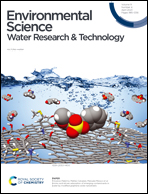Identifying water blending areas and associated iron release risk by analyzing sulfate and strontium concentration difference in a metropolitan drinking water distribution system†
Abstract
Blending of water produced by different water treatment plants (WTPs) has become common in metropolitan cities, particularly when multiple water sources are used for supplying drinking water. However, the effect of water blending in drinking water distribution systems (DWDSs) on iron release is poorly understood. Developing a method to identify water blending areas is also vital for water quality regulation. This field research first identified water blending areas in a metropolitan city by tracking sulfate and strontium concentration changes from finished water to tap water. The two parameters were selected because they were relatively stable in DWDSs and their concentrations were very different in finished water of different WTPs. The water supply areas with sulfate (or strontium) concentration close to that in the finished water of a specific WTP was categorized as a minimum blending area while the areas with dramatically varying sulfate (or strontium) concentrations were identified as blending areas receiving water from at least two WTPs. The water blending index was further calculated based on sulfate concentration, and the results corresponded well with the blending index calculated based on strontium concentration. Compared to the areas supplied with water from a single WTP, the areas with a frequent blending of groundwater and surface water had significantly more iron release, and these areas were characterized as iron release susceptible areas. In addition to water blending, a high level of residual iron in finished water also contributed to the elevation of iron concentration in DWDSs. This study provided a practical approach to identify water blending areas and could facilitate water quality regulation in large DWDSs.



 Please wait while we load your content...
Please wait while we load your content...